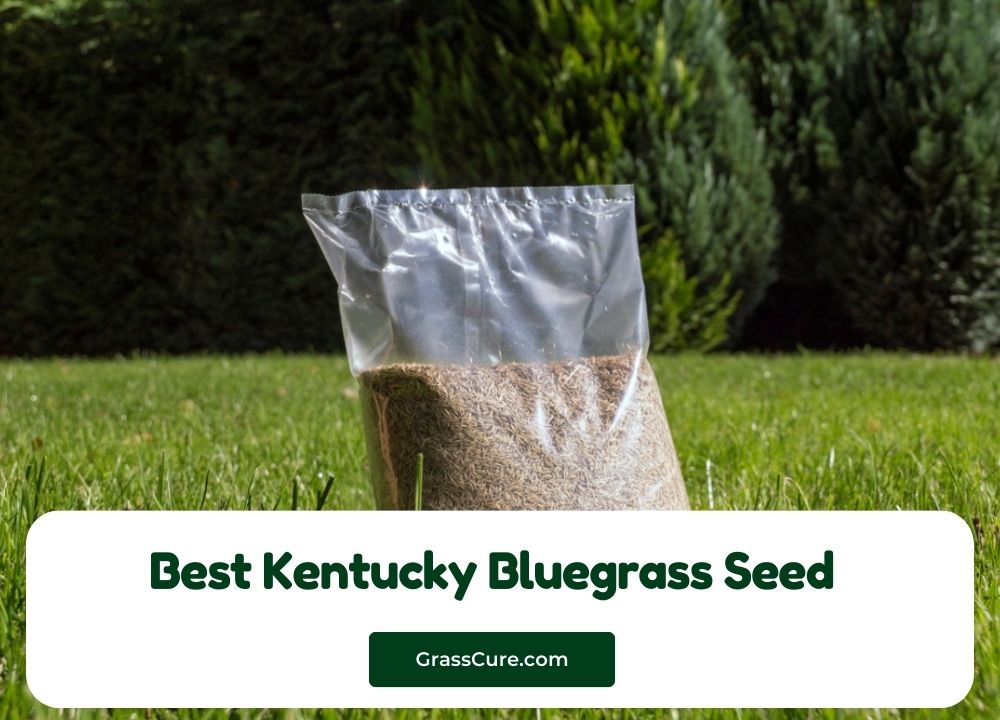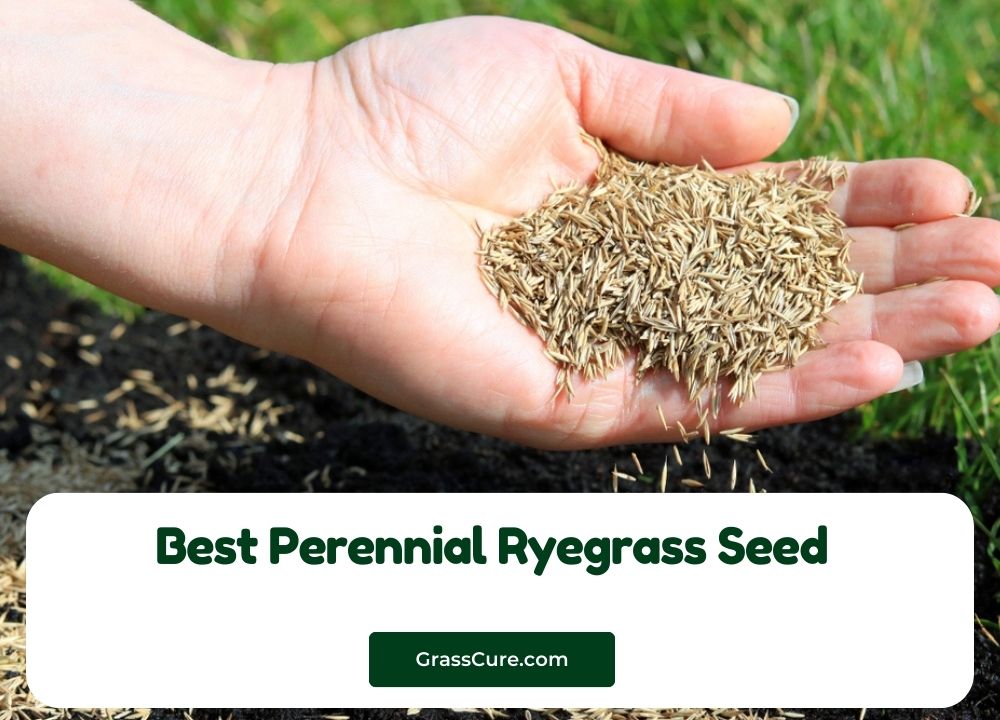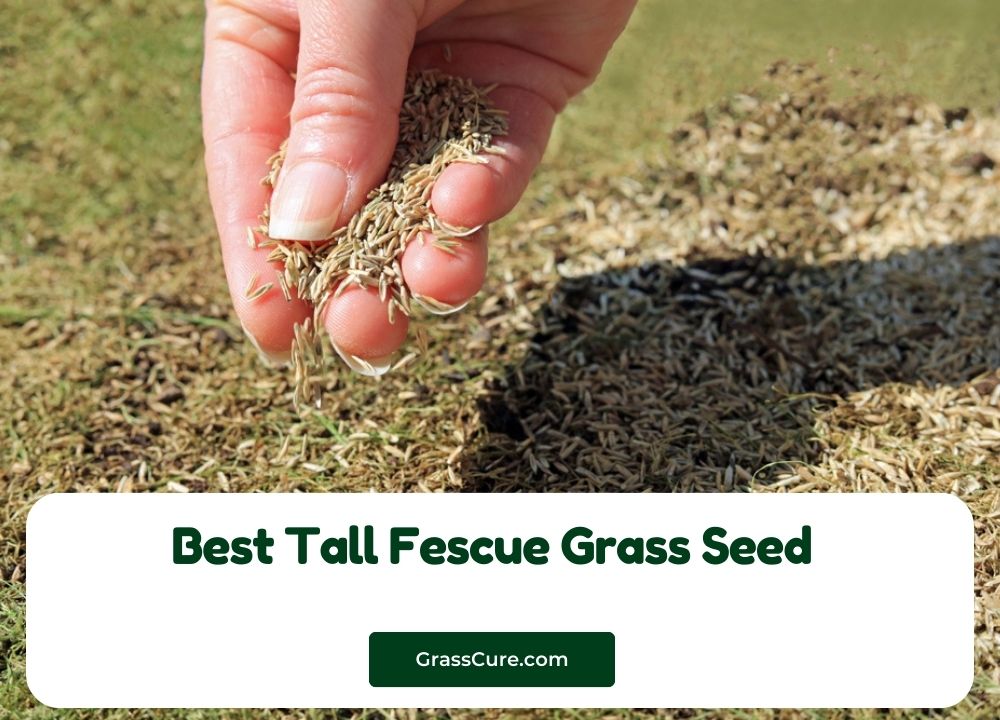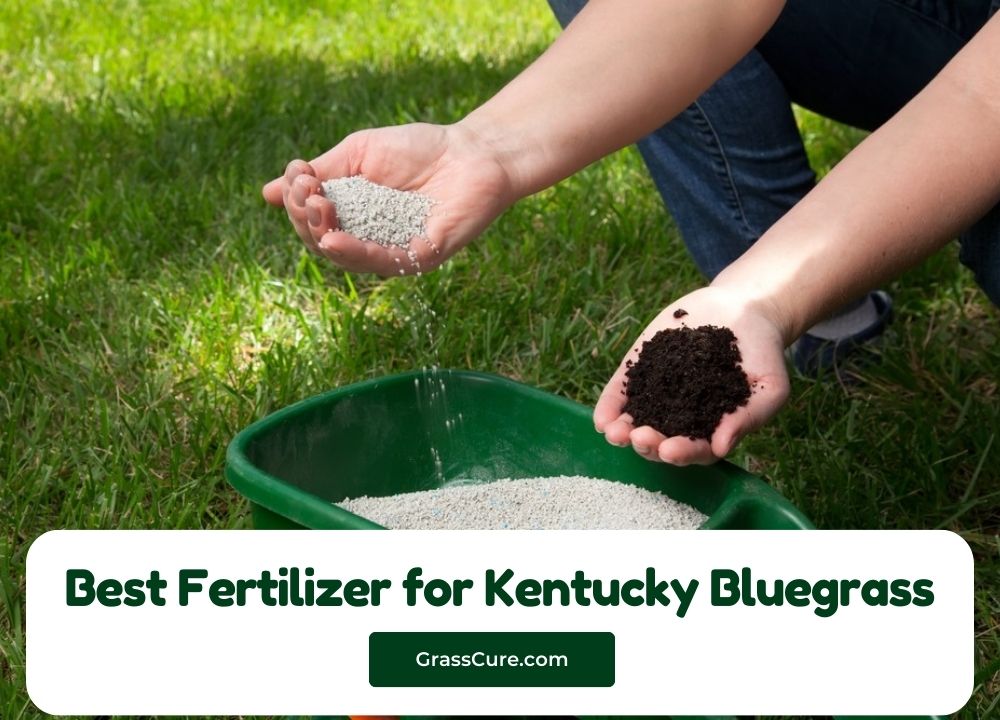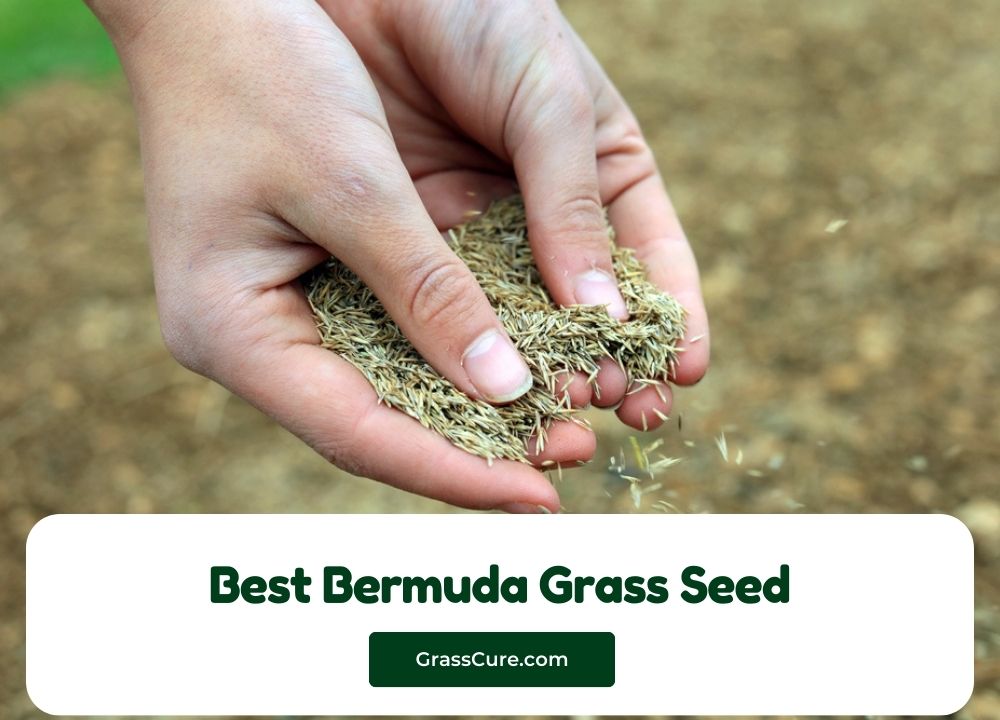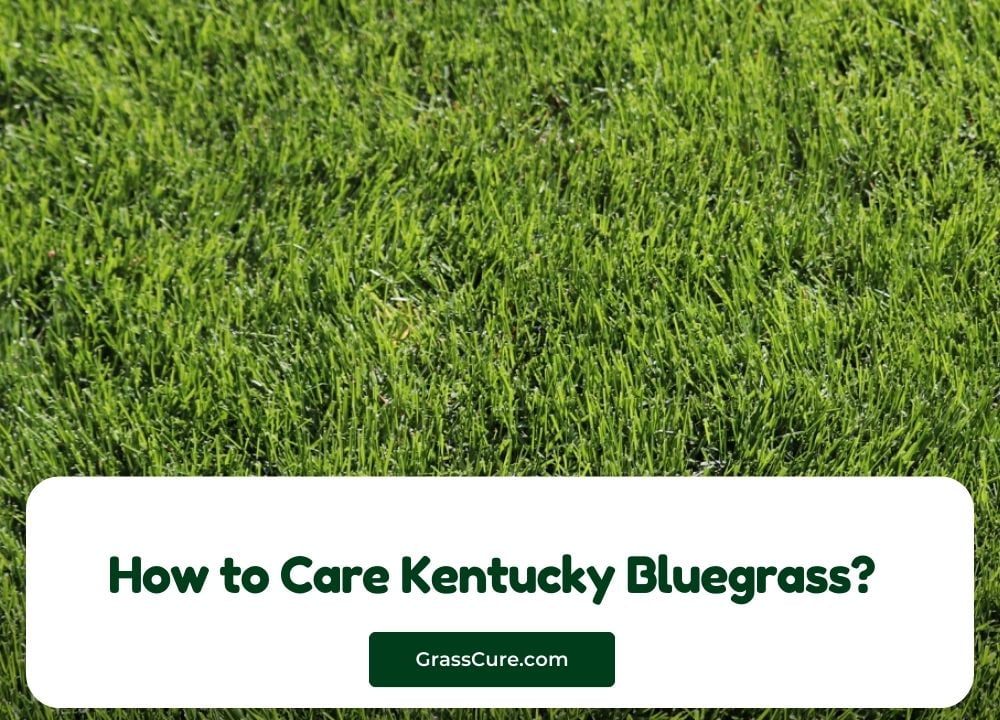Kentucky Bluegrass is a popular choice for creating lush, vibrant lawns, known for its rich green color, fine texture, and excellent cold tolerance. It’s ideal for cool-season climates and is often used in residential lawns, parks, and sports fields due to its durability and ability to recover from wear. Choosing the right Kentucky Bluegrass seed is crucial for ensuring a healthy, thick lawn that meets your specific climate and soil conditions. In this guide, we’ll explore the best Kentucky Bluegrass seed options and key factors to consider when selecting the perfect one for your lawn.
Contents
Choosing the Best Kentucky Bluegrass Seed
1. Scotts Turf Builder Grass Seed Kentucky Bluegrass Mix

Scotts Turf Builder Kentucky Bluegrass Mix is designed to grow dense, vibrant, and resilient turf. This blend not only provides high-quality grass seed but also includes a fertilizer and soil improver, making it a comprehensive solution for lawn care. With the added nutrients, this seed mix promotes quicker establishment and thicker growth, ideal for high-traffic areas or homeowners looking for a premium lawn.
Key Features:
- Fertilizer and Soil Improver: Enhances soil quality and provides essential nutrients for strong root growth.
- Dense, Green Turf: Known for producing a thick, green lawn with superior color.
- Cold Tolerant: Great for cool-season climates, ensuring your lawn stays green even during colder months.
- Drought Resistance: Helps reduce the need for frequent watering once the lawn is established.
- Coverage: A 5.6 lbs bag covers approximately 2,800 square feet.
Pros:
- Comprehensive seed, fertilizer, and soil improver in one product.
- Builds a lush, green lawn that is resistant to wear and tear.
- Ideal for homeowners looking for premium quality with less frequent watering.
Cons:
- Requires more watering initially to establish the lawn.
- Higher cost compared to regular seed mixes.
Best For:
Homeowners wanting a low-maintenance, high-quality lawn with excellent durability and aesthetics.
2. Jacklin Seed – Biltmore Blue Blend – 100% Kentucky Bluegrass

Jacklin Seed’s “Blue Genes” is a premium 100% Kentucky Bluegrass blend known for its fine texture, deep green color, and excellent adaptability. This certified grass seed is designed for both homeowners and professionals seeking a high-quality lawn that is resilient and long-lasting. The seed is well-suited for cool-season climates, offering superior performance in colder weather, and is ideal for creating thick, attractive lawns.
Key Features:
- 100% Kentucky Bluegrass: Pure bluegrass seed for consistent, dense, and uniform turf.
- Certified Seed: Guaranteed quality and purity, free from contaminants.
- Cold Tolerant: Exceptional cold weather performance, making it perfect for northern climates.
- Durable & Self-Repairing: Forms a dense, durable lawn that can repair itself through rhizomes.
- Coverage: A 10 lbs bag covers approximately 4,000 square feet.
Pros:
- Pure Kentucky Bluegrass with excellent color and texture.
- High resilience to wear and self-repairs, reducing the need for overseeding.
- Ideal for cool-season areas and colder climates.
Cons:
- Slower germination compared to other grass types (can take 2-3 weeks).
- Requires consistent watering and maintenance during establishment.
Best For:
- Homeowners looking for a dense, rich, and self-sustaining lawn in cool climates. Ideal for those wanting a high-quality, pure Kentucky Bluegrass lawn with long-term durability.
3. Outsidepride Midnight Kentucky Bluegrass Lawn Grass Seed
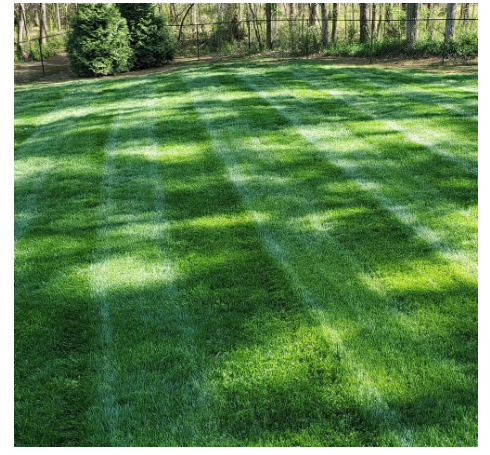
Outsidepride Midnight Kentucky Bluegrass Seed is a premium lawn seed variety known for its deep green color, fine texture, and excellent adaptability to cold and drought conditions. The Midnight variety is highly prized for its shade tolerance, traffic resistance, and ability to develop a strong, deep root system. Additionally, the seed is OptiGrowth coated, promoting better germination and establishment, making it an excellent choice for homeowners seeking a beautiful, durable lawn.
Key Features:
- Cold and Drought Tolerant: Performs well in both cold climates and periods of limited water.
- Sun-Loving: Thrives in areas with full sun but can tolerate partial shade.
- High Traffic Tolerance: Ideal for high-traffic areas such as yards with kids or pets.
- OptiGrowth Coating: Improves seedling establishment and enhances root development.
- Coverage: A 25 lbs bag covers large areas, approximately 10,000-15,000 square feet depending on planting conditions.
Pros:
- Deep, dark green color and fine texture for a professional-grade lawn.
- Highly durable, with resistance to wear and excellent recovery due to its rhizome system.
- The OptiGrowth coating ensures faster, healthier growth and root establishment.
Cons:
- Takes longer to establish compared to faster-growing grass types.
- Requires consistent watering during initial stages of growth for best results.
Best For:
- Homeowners seeking a top-tier, durable lawn that can withstand foot traffic and tough environmental conditions. Perfect for those in cooler climates who desire a high-quality, aesthetically pleasing lawn with long-term resilience.
4. Midnight Kentucky Bluegrass Seed (Certified)
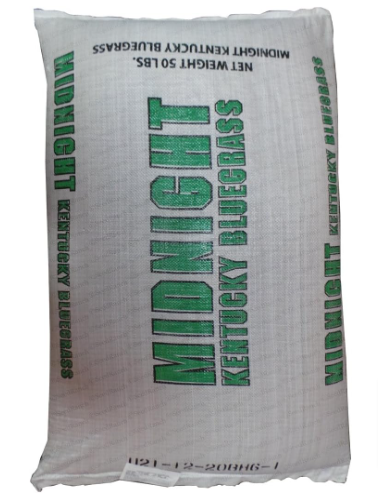
Midnight Kentucky Bluegrass is one of the most highly regarded grass seed varieties, known for its rich, dark green color, fine leaf texture, and excellent cold tolerance. This certified seed is pure and free from contaminants, ensuring high-quality results for lawns, sports fields, and parks. The Midnight variety is drought-resistant and capable of forming a dense, durable turf that can recover from damage through its rhizome growth system, making it ideal for both aesthetic appeal and functionality.
Key Features:
- Certified Seed: Guaranteed purity and quality, with no unwanted weed seeds or fillers.
- Dark Green Color: One of the darkest green Kentucky Bluegrass varieties available.
- Cold and Drought Resistant: Performs exceptionally well in cool climates and can tolerate periods of drought once established.
- Fine Leaf Texture: Gives lawns a soft, carpet-like feel and uniform appearance.
- Self-Repairing: Spreads via rhizomes, allowing it to recover from damage and wear.
- Coverage: A 50 lbs bag covers approximately 25,000-35,000 square feet.
Pros:
- Produces a stunning dark green, dense lawn with superior aesthetic quality.
- Excellent durability, traffic resistance, and recovery ability.
- Certified seed ensures top-tier performance and uniformity.
Cons:
- Slower to establish compared to faster-growing grass varieties (can take 2-3 weeks for germination).
- Requires more care during initial establishment, including frequent watering.
Best For:
- Homeowners and professionals looking for a premium-grade lawn with exceptional color and durability. Perfect for cool-season climates, high-traffic areas, and those seeking a low-maintenance, self-repairing turf for long-term performance.
5. Barenbrug Turf Blue Pro Kentucky Bluegrass Seed
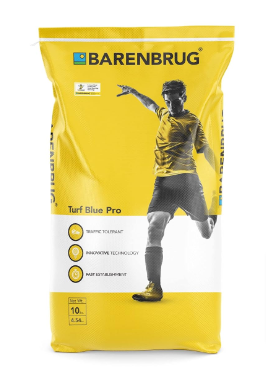
Barenbrug Turf Blue Pro Kentucky Bluegrass Lawn Seed is designed for creating a lush, durable lawn that thrives in various conditions. This premium seed mix features Yellow Jacket seed coating, which enhances germination and protects the seeds during establishment. The mix is crafted for all-season performance, making it an excellent choice for homeowners seeking a resilient lawn that can withstand foot traffic and environmental stressors.
Key Features:
- Yellow Jacket Seed Coating: A unique coating that retains moisture, promotes faster germination, and protects seeds from pests and diseases.
- All-Season Durability: Suitable for various climates, providing a strong lawn that maintains its color and density throughout the seasons.
- Traffic Tolerance: Designed to endure foot traffic, making it ideal for families, pets, and recreational areas.
- Rapid Establishment: The coated seeds germinate quickly and establish a strong root system for lasting resilience.
- Coverage: A 10 lbs bag covers approximately 4,000 square feet.
Pros:
- The Yellow Jacket coating enhances germination rates and overall seed performance.
- Produces a dense, vibrant lawn with excellent wear tolerance.
- Suitable for diverse growing conditions, ensuring year-round lawn health.
Cons:
- May require regular maintenance, including watering and mowing, to achieve optimal results.
- Slightly higher cost compared to uncoated grass seed options.
Best For:
Homeowners looking for a robust, low-maintenance lawn that can handle wear and tear while maintaining a lush appearance. Ideal for both sunny and partially shaded areas, this seed mix is perfect for anyone wanting a durable lawn that thrives in a variety of conditions.
6. Pennington Kentucky Smart Seed, 3 LB, Green
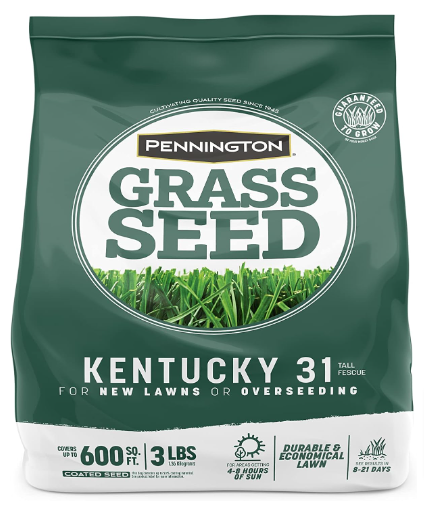
Pennington Kentucky Smart Seed is a premium blend designed specifically for creating a vibrant, lush lawn that thrives in a variety of conditions. This 3-pound bag is formulated to provide excellent coverage while being water-efficient, making it an ideal choice for environmentally conscious homeowners. The seed blend features a mix of Kentucky Bluegrass, which is known for its dense growth and rich color, along with other grass types that enhance drought tolerance and adaptability.
Key Features:
- Water-Efficient Technology: This seed blend utilizes advanced technology to require up to 30% less water than traditional grass seeds, making it a sustainable option for water conservation.
- Rapid Germination: Designed for quick establishment, the seeds germinate within 7-12 days, allowing homeowners to enjoy a lush lawn sooner.
- Drought Tolerance: The blend is formulated to withstand dry conditions, ensuring your lawn remains green and healthy even during periods of limited rainfall.
- Coverage Area: A 3-pound bag covers approximately 1,000 square feet, providing ample seed for small to medium-sized lawns.
Pros:
- Promotes a healthy, green lawn with minimal water usage.
- Fast germination time allows for quick establishment.
- Suitable for various soil types and climates, enhancing versatility.
Cons:
- Requires consistent watering during the establishment phase to ensure successful germination.
- Some users may find it slightly more expensive than standard seed blends.
Best For:
Homeowners looking for an environmentally friendly lawn solution that conserves water while maintaining a beautiful, healthy yard. This blend is particularly well-suited for areas with variable climates and those seeking to reduce their water footprint without sacrificing lawn quality.
7. Barenbrug USA TVKBG7 TV 7 lb Kentucky Bluegrass Seed
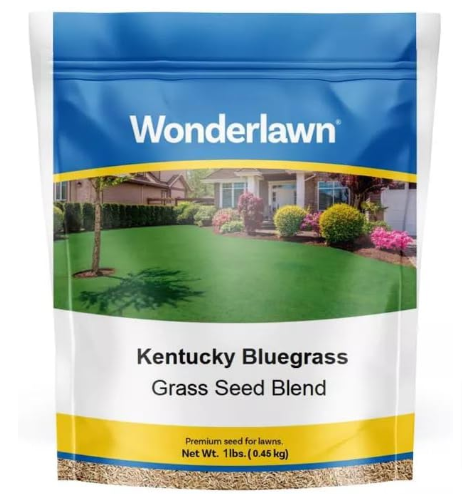
Barenbrug USA TVKBG7 is a high-quality Kentucky Bluegrass seed blend designed for homeowners and landscapers seeking to establish a lush, durable lawn. This 7-pound bag features a specially selected mix of elite Kentucky Bluegrass varieties that thrive in a range of climates and growing conditions, making it an excellent choice for both residential and commercial applications.
Key Features:
- Premium Seed Blend: The TVKBG7 mix includes high-performing Kentucky Bluegrass cultivars known for their rich color, fine texture, and robust growth.
- Durability: This blend is engineered for high wear tolerance, making it suitable for lawns that experience heavy foot traffic from families, pets, and recreational activities.
- Self-Repairing Ability: Kentucky Bluegrass spreads through underground rhizomes, enabling it to self-repair and fill in bare spots over time, contributing to a thicker and healthier lawn.
- Coverage Area: A 7-pound bag typically covers approximately 2,000 to 3,500 square feet, depending on the seeding rate, providing excellent value for larger lawn areas.
Pros:
- Exceptional drought resistance and adaptability to various soil types.
- Quick establishment with optimal growing conditions, allowing for a vibrant lawn.
- High disease resistance, helping to maintain lawn health throughout the growing season.
Cons:
- Requires regular maintenance, including proper watering and fertilization, to achieve the best results.
- Longer germination time (14-30 days) compared to some fast-germinating grass types, which may require patience during establishment.
Best For:
- Homeowners and landscapers looking to create a stunning, resilient lawn that can withstand heavy use while providing a beautiful appearance. This blend is particularly suitable for areas prone to wear and tear, making it an ideal choice for family yards, parks, and recreational spaces.
What to Consider When Choosing Kentucky Bluegrass Seed
When selecting Kentucky Bluegrass seed for your lawn, several key factors will help ensure you make the right choice for your specific conditions and goals. Here are the most important considerations:
Climate Suitability
- Cool-Season Grass: Kentucky Bluegrass thrives in cooler climates, typically found in the northern United States. Ensure that your local climate aligns with the needs of this grass type for optimal growth.
Soil Type
- Soil Quality: Conduct a soil test to determine pH levels and nutrient content. Kentucky Bluegrass prefers well-drained, fertile soils, so consider amending your soil accordingly.
- Soil Texture: Sandy or loamy soils are ideal, while heavy clay may require amendments to improve drainage.
Sunlight Exposure
- Light Requirements: Kentucky Bluegrass prefers full sun but can tolerate partial shade. Assess the sunlight availability in your lawn area to choose a seed blend suited for those conditions.
Water and Maintenance Needs
- Watering Requirements: Kentucky Bluegrass needs consistent moisture, especially during establishment. Consider your ability to provide adequate irrigation, particularly during dry spells.
- Maintenance: This grass type requires regular mowing and fertilization. Determine how much time and effort you can invest in lawn care.
Traffic Tolerance
- Foot Traffic: If your lawn will experience heavy foot traffic from children, pets, or recreational activities, select a seed blend known for its durability and resilience to wear.
Growth Rate and Germination Time
- Establishment Period: Kentucky Bluegrass typically takes longer to germinate (14-30 days) compared to other grasses. Plan for this timeframe and be patient as your lawn establishes itself.
Disease Resistance
- Disease Tolerance: Look for seed varieties with good resistance to common diseases, such as leaf spot and brown patch, especially if you live in areas prone to such issues.
Seed Quality and Certification
- Certification: Choose certified seed varieties to ensure purity and quality, minimizing the presence of weed seeds or undesirable grasses.
- Brand Reputation: Research and select seeds from reputable brands known for their quality and performance.
Blend Composition
- Seed Blends: Some seed mixes combine Kentucky Bluegrass with other grass types (like fescue or ryegrass) for improved drought tolerance or faster germination. Consider what blend might best suit your lawn’s specific needs.
How to Plant Kentucky Bluegrass for Best Results
Successfully planting Kentucky Bluegrass involves several steps to ensure optimal growth and establishment. Here’s a detailed guide on how to plant Kentucky Bluegrass for the best results:
Soil Preparation
- Test the Soil: Conduct a soil test to determine pH and nutrient levels. Kentucky Bluegrass prefers a pH of 6.0 to 7.0.
- Amend the Soil: Based on the test results, amend the soil with lime (to raise pH) or sulfur (to lower pH) as needed. Add organic matter, such as compost, to improve soil structure and fertility.
- Tilling: If the soil is compacted, till the top 4-6 inches to aerate and break up clumps.
Seed Selection
- Choose Quality Seed: Select high-quality, certified Kentucky Bluegrass seed suited to your climate and lawn conditions. Consider blends that provide disease resistance and drought tolerance.
Seeding Techniques
Timing: The best time to plant Kentucky Bluegrass is in late summer to early fall (August to October) or in early spring (March to April). Fall is preferred, as it allows for cooler temperatures and increased moisture.
Seed Distribution: Use a broadcast spreader for even seed distribution. Aim for a seeding rate of 1 to 2 pounds per 1,000 square feet, depending on the specific variety and desired density.
Covering the Seed
- Lightly Rake the Soil: After seeding, lightly rake the area to incorporate the seeds into the soil (about 1/4 inch deep). Avoid burying them too deeply, as Kentucky Bluegrass requires light for germination.
- Roll the Area: Use a lawn roller to press the soil and seed down, ensuring good seed-to-soil contact.
Watering
- Initial Watering: Immediately after planting, water the area thoroughly to help settle the soil and provide moisture for germination.
- Keep Soil Moist: Water lightly and frequently (1-2 times per day) until the seeds germinate. As the grass establishes, gradually reduce the frequency but increase the depth of watering. Aim for about 1 inch of water per week, either from rainfall or irrigation.
Fertilization
- Starter Fertilizer: Apply a starter fertilizer high in phosphorus (like a starter fertilizer with a ratio of 10-20-10) at the time of seeding to promote root development.
- Post-Establishment Fertilization: Once the grass reaches about 3 inches in height, apply a balanced fertilizer to support continued growth.
Mowing
- First Mow: Wait until the grass is about 3-4 inches tall before the first mow. Set the mower blades high (around 3 inches) to avoid stressing the young grass.
- Regular Mowing: Continue to mow regularly to maintain a height of about 2.5 to 3.5 inches for optimal health and appearance.
Weed Control
- Pre-Emergent Herbicides: Avoid applying pre-emergent herbicides during seeding, as they can inhibit seed germination. Once the grass is established (after the first mowing), you can use post-emergent herbicides if needed.
- Manual Weeding: Regularly check for weeds and remove them manually if they appear, especially during the establishment phase.
Common Issues with Kentucky Bluegrass and How to Avoid Them
While Kentucky Bluegrass is known for its beauty and durability, it can still face several common issues that may hinder its growth and health. Here’s a look at these problems and how to avoid or manage them effectively:
Drought Stress
- Symptoms: Brown patches, wilting, and reduced growth.
- Prevention:
- Watering: Ensure consistent and adequate watering, especially during dry periods. Aim for about 1 inch of water per week, adjusting for rainfall.
- Mulching: Apply a layer of mulch or grass clippings to retain moisture and regulate soil temperature.
- Deep Rooting: Encourage deep root growth by watering less frequently but more deeply.
Poor Soil Quality
- Symptoms: Stunted growth, poor color, and weak turf.
- Prevention:
- Soil Testing: Conduct soil tests to check for pH levels and nutrient content. Amend the soil as needed to create optimal growing conditions.
- Organic Matter: Incorporate compost or organic fertilizers to improve soil structure and fertility.
Thatch Buildup
- Symptoms: Thick, spongy layer of dead grass and roots, leading to water and nutrient blockage.
- Prevention:
- Aeration: Aerate your lawn annually, especially in high-traffic areas, to reduce thatch buildup and improve root health.
- Mowing: Maintain proper mowing height to avoid excessive thatch accumulation.
Diseases
- Common Diseases: Brown patch, leaf spot, and dollar spot.
- Prevention:
- Proper Watering: Water early in the morning to allow grass to dry out during the day, reducing disease risk.
- Fertilization: Avoid over-fertilizing, as excessive nitrogen can lead to disease susceptibility.
- Good Air Circulation: Ensure adequate spacing and mowing practices to promote airflow.
Pest Infestation
- Common Pests: Grubs, chinch bugs, and sod webworms.
- Prevention:
- Regular Monitoring: Check for signs of pest damage, such as wilting or uneven growth.
- Healthy Lawn Practices: Maintain a healthy lawn to reduce pest attraction. Healthy turf is less likely to be infested.
- Natural Predators: Encourage beneficial insects that prey on common lawn pests.
Weed Invasion
- Symptoms: Competition for nutrients and water, leading to weakened grass.
- Prevention:
- Pre-Emergent Herbicides: Apply pre-emergent herbicides in early spring to prevent weed seeds from germinating.
- Regular Mowing: Keep your grass at the recommended height to shade out weeds and reduce their growth potential.
- Healthy Lawn Practices: Promote dense turf growth to outcompete weeds naturally.
Improper Mowing Practices
- Symptoms: Scalping, uneven growth, and increased stress.
- Prevention:
- Mowing Height: Maintain a mowing height of 2.5 to 3.5 inches to promote healthy growth and root development.
- Sharp Blades: Use sharp mower blades to make clean cuts, reducing stress and promoting better recovery.
- Mowing Frequency: Mow regularly, removing no more than one-third of the grass height at a time.
Poor Establishment
- Symptoms: Patchy growth and thin turf.
- Prevention:
- Follow Planting Guidelines: Adhere to recommended seeding rates, soil preparation, and watering practices during establishment.
- Optimal Timing: Plant at the appropriate time of year (late summer to early fall) for the best results.
Conclusion
Kentucky Bluegrass is a sought-after choice for homeowners and landscapers alike, prized for its lush appearance, durability, and ability to thrive in cooler climates. However, to achieve a vibrant and healthy lawn, it’s essential to be proactive in addressing common issues that can arise during growth and establishment. By understanding the specific needs of Kentucky Bluegrass, from soil preparation and watering to pest management and disease prevention, you can create an environment that promotes optimal growth.
Selecting high-quality seed, following best practices for planting, and implementing ongoing maintenance strategies will significantly enhance the chances of cultivating a beautiful lawn. With the right care and attention, Kentucky Bluegrass can provide a stunning, resilient landscape that withstands the test of time and elevates the aesthetic appeal of your outdoor space. Ultimately, investing time and effort into your Kentucky Bluegrass lawn will yield rewarding results, providing a lush and inviting area for recreation, relaxation, and enjoyment.
FAQ About Kentucky Bluegrass
1. What is Kentucky Bluegrass?
Kentucky Bluegrass is a cool-season grass known for its rich green color, fine texture, and excellent durability. It is widely used for lawns, parks, and sports fields, particularly in northern climates.
2. What are the ideal growing conditions for Kentucky Bluegrass?
Kentucky Bluegrass thrives in well-drained, fertile soils with a pH of 6.0 to 7.0. It prefers full sun but can tolerate partial shade. It is best suited for cool-season areas with cold winters and moderate summers.
3. How do I plant Kentucky Bluegrass?
To plant Kentucky Bluegrass:
- Prepare the soil by testing and amending it as needed.
- Choose high-quality seed and broadcast it evenly.
- Lightly rake the area to cover the seeds and water thoroughly.
- Maintain consistent moisture until the seeds germinate, usually within 14-30 days.
4. How often should I water my Kentucky Bluegrass lawn?
During establishment, water lightly and frequently (1-2 times per day) to keep the soil consistently moist. Once established, aim for about 1 inch of water per week, adjusting for rainfall and dry periods.
5. When is the best time to plant Kentucky Bluegrass?
The optimal times for planting Kentucky Bluegrass are late summer to early fall (August to October) or early spring (March to April). Fall planting is preferred for cooler temperatures and increased moisture.
6. What are the common issues with Kentucky Bluegrass?
Common issues include drought stress, poor soil quality, thatch buildup, diseases, pest infestations, weed invasions, and improper mowing practices. Awareness of these problems and proactive care can help mitigate them.
7. How can I improve the health of my Kentucky Bluegrass lawn?
To improve lawn health:
- Test and amend your soil as needed.
- Water consistently and deeply.
- Mow regularly at the appropriate height (2.5 to 3.5 inches).
- Fertilize appropriately, avoiding excessive nitrogen.
- Aerate the lawn annually to reduce compaction and thatch.
8. Can Kentucky Bluegrass survive in shady areas?
While Kentucky Bluegrass prefers full sun, some varieties can tolerate partial shade. However, in heavily shaded areas, you may want to consider blending it with shade-tolerant grasses for better results.
9. How do I control weeds in my Kentucky Bluegrass lawn?
To control weeds:
- Use pre-emergent herbicides in early spring to prevent weed seed germination.
- Maintain a healthy, dense lawn to outcompete weeds naturally.
- Manually remove weeds as needed, especially during the establishment phase.
10. How do I know if my Kentucky Bluegrass lawn is healthy?
A healthy Kentucky Bluegrass lawn is characterized by a dense, vibrant green color, even growth, resistance to pests and diseases, and minimal thatch buildup. Regular maintenance and proper care will contribute to its overall health and appearance.
References for Kentucky Bluegrass Information
- University of Kentucky College of Agriculture, Food and Environment. (n.d.). Kentucky Bluegrass. Retrieved from UK Agriculture.
- This source provides in-depth information on the characteristics, benefits, and maintenance of Kentucky Bluegrass.
- Penn State Extension. (n.d.). Lawn Care: Kentucky Bluegrass. Retrieved from Penn State Extension.
- This guide covers best practices for planting, caring for, and maintaining Kentucky Bluegrass lawns.
- Ohio State University Extension. (2021). Managing Kentucky Bluegrass Lawns. Retrieved from OSU Extension.
- A comprehensive resource detailing the establishment, maintenance, and common issues associated with Kentucky Bluegrass.
- North Carolina State University Extension. (2021). Choosing the Right Grass. Retrieved from NCSU Extension.
- This article compares various grass types, including Kentucky Bluegrass, providing insights into their suitability for different climates and conditions.
- Missouri Botanical Garden. (n.d.). Lawn Care Guide: Kentucky Bluegrass. Retrieved from Missouri Botanical Garden.
- This source discusses lawn care techniques, including watering, fertilization, and mowing practices specific to Kentucky Bluegrass.
- USDA Plant Database. (n.d.). Poa pratensis – Kentucky Bluegrass. Retrieved from USDA PLANTS.
- A scientific overview of Kentucky Bluegrass, including its taxonomy, distribution, and ecological characteristics.
- Turfgrass Science. (2021). Establishing Kentucky Bluegrass Lawns. Retrieved from Turfgrass Science.
- An article detailing the methods and best practices for establishing and maintaining healthy Kentucky Bluegrass lawns.
